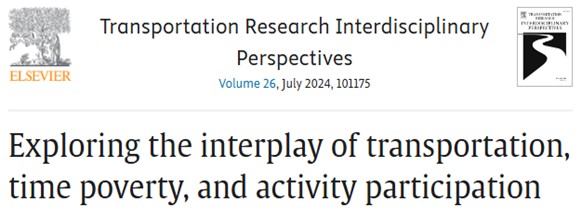Ignacio Tiznado Aitken, Matthew Palm, Steven Farber
Abstract
Transport-related social exclusion describes how a lack of transportation resources hinders participation in society. Time poverty refers to situations in which work and household commitments deprive people of time for other meaningful or necessary activities. Research integrating both concepts is limited, despite evidence that excessive daily travel times can lead to transport-related time poverty.
We propose a conceptual framework to bridge existing time use and transport-related social exclusion frameworks to understand transportation’s contribution to time poverty. We apply our framework to the Canadian General Social Survey (GSS)’s time use module by conducting a latent class cluster analysis (LCCA) using individual characteristics, transportation and urban form features, and time poverty standards. Utilizing a data-driven approach, we propose thresholds to define when an individual is at risk of time poverty and when they can be considered time-poor. Similarly, we define these thresholds for transport-related time poverty based on existing literature.
Our findings show that one in five Canadians over 24 years old can be classified as time poor, 23 % experience transport-related time poverty and 5 % experience both general and transport-related time poverty. We found ten profiles, which we analyzed into three subgroups: (i) high time poverty and medium rates of transport-related time poverty, (ii) low time poverty and medium to high incidence of transport-related time poverty, and (iii) very low time poverty and transport-related time poverty. From the first subgroup, four profiles display the highest proportions of time poverty (61 % and 70 %), as well as moderated levels of transport-related time poverty (22 % to 32 %). More than 450,000 socially disadvantaged Canadians, mainly characterized by women single parents with medium to low incomes, were categorized into two clusters, where 290,000 experience time poverty, 123,000 transport-related time poverty, and 70,000 both simultaneously. Building on these findings, we discussed the potential impact of different transport and land use policies to alleviate transport-related time poverty as well as avenues for future research.
